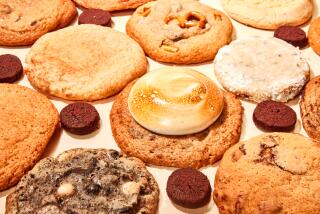Danish Pastry: A Mistake That Conquered the World : Food: The treat originated 350 years ago when a French baker forgot the butter, folding it in later to try to cover up his mistake. He ended up with a light dough that traveled the globe.
- Share via
COPENHAGEN — Danish pastry is really French and was born of a baker’s mistake, but it has nearly become all things to all people.
It is a morning staple in the United States. To order it, you don’t even have to say pastry--just Danish.
Europeans like their Danish lighter, more elegant.
In Denmark, no party or leisurely Sunday breakfast is complete without the pastry, which the Danes call Viennese.
“It’s like the Danish flag, which we fly every time we celebrate something,” said Merete Thomsen, a secretary in Copenhagen.
To Germans, the pastry is a “Copenhagener.”
According to the Danish bakers’ union, the distinctive dough was created 350 years ago by Claudius Gelee, a French apprentice baker who forgot to add butter to the flour and tried to hide his mistake by folding lumps of it into the dough.
To the astonishment of Gelee and his colleagues, the result was the lightest dough ever seen in France.
Gelee opened a Paris cafe in 1622 where he served the pastry the French call “a thousand leaves” and repeated his success in Florence. Italians call it “folded pastry.”
Italian bakers took the pastry to Austria. It journeyed from there to Denmark when Danish bakers went on strike and replacements imported from Austria brought the “Viennese bread” along.
From then on, the pastry became Danish to the rest of the world--probably, said Ebbe Larsen of the bakers’ union, because Danish bakers emigrated to so many countries.
The secret of good Danish is chilling the ingredients so repeated folding and rolling will produce distinct layers of dough and butter.
Danes fill the pastries with jam, fruit, nuts or cream. Among their favorites are a long Danish filled with sugar and marzipan, topped with slivered almonds; a round one with vanilla custard in the middle; a spiral, rum-soaked version called a snail, and a raisin Danish for holidays.
Instead of butter, many bakers use a special margarine with a high melting point. The best bakers work the dough by hand, contending that machines make it too hard and dry.
Peter Bosse said half of his Copenhagen bakery’s production is Danish pastry, which he said “will never go out of fashion.” He serves about 1,200 customers a day.
More to Read
Eat your way across L.A.
Get our weekly Tasting Notes newsletter for reviews, news and more.
You may occasionally receive promotional content from the Los Angeles Times.








